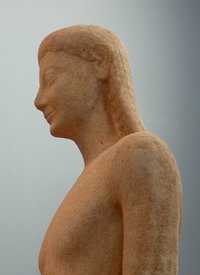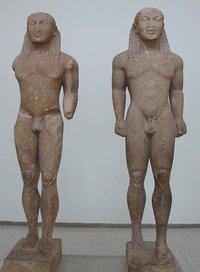Kouros
|
|
Samoskouros.JPG
A kouros (plural kouroi) is a statue of a male youth, dating from the archaic period of Greek sculpture (about 650 BC to about 500 BC). The earliest kouroi were made of wood and have not survived, but by the 7th century the Greeks had learned the art of carving stone with iron tools, and were making kouroi from stone, particularly marble from the islands of Paros and Samos.
The Ancient Greek word kouros meant a male youth, and is used by Homer to refer to young soldiers. From the fifth century the word referred specifically an adolescent, beardless male, but not a child. Modern art historians have used the word to refer to this specific type of male nude statue since the 1890s. Kouroi were also commonly known as Apollos, since it was believed that all kouroi depicted Apollo.
Kouroi were created at a time when Greece was under the cultural influence of Ancient Egypt, as can be seen by their characteristic rigid pose, reminiscent of statues of Egyptian kings. Greeks would have seen these statues when visiting Egypt as merchants or mercenary soldiers hired by Egyptians. Kouroi nearly always stand with their arms at their sides and their fists clenched, although a few show one arm extended forward from the elbow, holding an offering. They always stand with their left leg slightly forward. This was also a common pose in Egyptian statuary.
Kouroi are always naked, wearing at most a belt and occasionally boots. Their faces and heads show a cultural influence from Crete: they wear their hair long and braided or beaded in the Cretan fashion, and their eyes sometimes have a recognisably Egyptian aspect, which was copied in Cretan art. Later kouroi show more naturalistic poses and their hair styles become more typical of mainland Greece. Kouroi always depict young men, ranging from adolescence to early maturity. In cemeteries, they showed the deceased as the Greek ideal of masculinity.
In very early times, it is likely that kouroi were thought to possess magical properties, and to be actual representations of the gods. By the 7th century, the earliest period for which sources exist, kouroi had come to serve two purposes. They were presented to temples as devotional offerings by prominent Greeks, as is shown by the inscriptions which frequently appear on their plinths. They were also placed in cemeteries to mark the graves of prominent citizens.
Kouroi, however, were never intended to be representations of actual persons. One of the best known kouroi is the grave-marker of Kroisos, an Athenian soldier. The inscription on his statue reads: "Stop and show pity beside the marker of Kroisos, dead, whom once in battle's front rank raging Ares destroyed." The word "marker" (sema) tells us that this is a symbolic representation of Kroisos, not a portrait.
Another well-known work is the double kouros known as Kleobis and Biton, found at Delphi. These statues date from about 580 BC and are representations of two semi-mythical heroes of Argos in the Peloponnese. Although an inscription identifies them as Kleobis and Biton, they are typical kouroi, representing the Archaic Peloponnesian virtues of filial piety and physical strength rather than actual persons.
Missing image Ac.athenskouros.jpg Kouros in the National Archaeological Museum, Athens |
Missing image Ac.thebeskouros.jpg Head of a kouros in the National Archaeological Museum, Athens |
In the 6th century kouroi grew larger as the Greeks became richer and more confident with marble sculpture. Some were three or even four times lifesize. Some of the largest were made for the great sanctuary of the goddess Hera on Samos, which was lavishly endowed by the tyrant Polycrates. One of these giant kouroi, at five metres tall the largest ever found, was unearthed in 1981 and is now in the Samos Archeological Museum, which had to be rebuilt to accommodate it. An inscription on its left thigh tells us that the statue was dedicated to Hera by an Ionian nobleman called Isches.
Most kouroi were commissioned by aristocrats as offerings to temples, or by the families of aristocrats to place over their graves. Marble sculpture was very expensive and only the wealthiest could afford to pay sculptors to create these works. Kouroi are therefore a representation of the wealth and power of the Greek aristocratic class, and as this class lost its power in the 6th century, so the kouros went out of fashion both politically and artistically.
By the end of the 6th century, the kouroi were giving way to naturalistic sculptures of living people. Among the earlier representations of real people are the statues of Harmodius and Aristogeiton, erected in Athens in about 500 BC. These figures (see the illustration at the Harmodius and Aristogeiton article) still show some of the formality of the kouros tradition, but are generally more lifelike. It is significant that these statues were a memorial to the establishment of Athenian democracy. They thus represent the replacement of both the kouros and the system of aristocratic rule which it represented.
Related articles
External link
- Samos Archaeological Museum (http://hellas.teipir.gr/Thesis/Samos/english/tdk158.html)
- Uncertain Provenance: The Getty Kouros (http://www.getty.edu/art/collections/objects/o12908.html)


